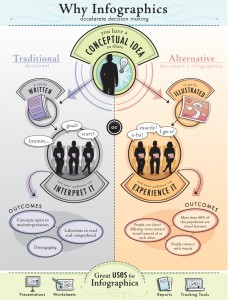Upon reading the excerpts of Lockwood, Pink & Martin, I confirmed that much of my thinking process is design based. I initially chose Commerce, specifically marketing, as my degree because I believed that my creative mind/alternative thinking process could generate new and innovative ideas in a typically structured industry. I am continually observing and am inspired by the world around me, so much of my thought process is from a “marketing perspective”. In reference to Thomas Lockwood’s foreward on design thinking, the idea that “big issues need new ways of thinking, which is exactly the point of design thinking,” is a concept that is central to my every day.
When given the opportunity to solve problems independently, my process often does not follow a set of predetermined steps. I do find it very important to understand the background of the problem and the intent behind finding a solution, but aside from this, the process varies greatly. I jot down my thoughts and write them on a blank white sheet of paper – this way, there is freedom for the ideas to grow, freedom for circles and arrows to be drawn, and freedom to see which ideas exist on their own. I try to write down all the ideas as they come, not lingering or dwelling on the details of individual components. I am a highly visual learner and strongly believe that visual elements are the most effective way to communicate ideas. Humans, as fundamentally lazy creatures, rely on their visual sense as a primary source of understanding. This idea has been proven with the emerging trend of infographics – graphic visual representations of information, data or knowledge. (Dictionary.com, see links below for examples. There is an infographic on why infographics work!)
Saying this, I use my understanding of the end audience (to whom I will be communicating the ideas) to structure my ideas. If criteria are given, I pay special attention to each of the categories that is to be evaluated. A few fundamental questions I ask myself when I am building a solution are, “What is the change in attitude and behaviour that I want to see?” and, “Does this solution have the potential to achieve this?” Aside from human tendency to use the things that they see as a heuristic for understanding, I believe that design can used to create a social and emotional connection. In Daniel Pink’s example about the “cutensils,” having a “bottle opener that looks like a smiling cat,” can distinguish itself from an everyday bottle opener as being “perfect for the consumer.”
My strength in the thinking process is creating and communicating ideas in an effective way. Much of the reading referred to “prototyping” which is a step in the design process I have not had much experience with. Perhaps it is due to the early stage of my design career or the limited scope I have worked within, but much of my experience has been through storyboarding. I have found that advantage of this approach is that throughout the entire process, the end audience (client) can refer to the storyboard be confident in the development of the idea. Although they may not be visual or design thinkers, a storyboard is visual evidence of what they are to expect. There is great value in the ability for a consumer to hold a product in their hands, to view a “spot” of an advertisement, or to taste a test recipe. Yet, there is a tendency for businesses today to shy away from a design approach. My hypothesis is that because we are so concerned about the bottom line, we are afraid to invest in alternative thinking. We would rather take an approach that is socially accepted and historically followed, than try a new approach and be personally accountable for its failure. Saying this, as technology increases and ideas flow freely through the internet, markets become saturated and businesses are forced to explore new ways of thinking to differentiate themselves.
Examples of infographics (click to make them bigger)
Why infographics:
Anatomy of a Vegan:
Senior citizens: the new Facebook user
Cheers,
Joyce
ps. With reference to, “For each reflection, we will ask you to also comment on at least two of your colleagues’ blogs/written pieces,” it’s not that I forgot, it’s just that someone had to post first, and that happened to be me haha!




Great reflection. You say that you are not experienced with prototyping, but really a storyboard is exactly that. The point is to show the idea to someone, and to yourself, and to be able to see if it makes sense once it’s all put together. I’m a pretty big fan of info graphics too, maybe because of my affinity to whiteboards and the way you can tell the entire story at once. The human mind has a bit of a hard time holding multiple ideas in focus at once, but with info graphics, whiteboards, storyboards, you can basically use the visual display to supplement your own mind’s carrying capacity. Awesome observations.
I think you bring a very good point and observation forward re: businesses being set in their ways with an attitude of “why re-invent the wheel” when it comes to thinking and making business decisions. It is true that in today’s cut-throat business industry where corporations are looking to streamline operations and trim away costs (i.e. let go of some employees if they feel others can handle more work), employees may be more inclined to go the safer route in order to ensure keeping their job. However, unless risks are taken and alternative ways of thinking are explored, the employee and the business will grow at a slower pace and be more homogenized – businesses today need to differentiate themselves in order to compete and design thinking can help foster that differentiation.